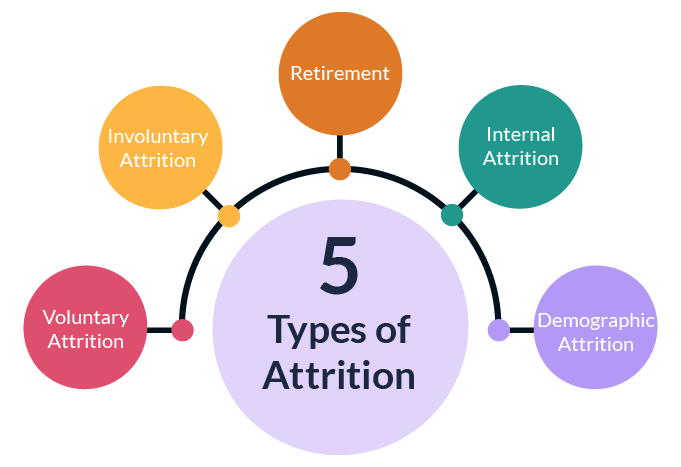When an employee resigns from an organization, its attrition rate increase. It can be beneficial to reduce attrition to retain the professionals your business already employs. Learning methods to control attrition can help you better appeal to your employees’ ideals and evaluate how to strengthen the internal functions of your company. In this article, we define attrition and its significance and explain techniques for managing it.
5 Types of Attrition

1. Voluntary Attrition
The most common type involves the voluntary, where the employees willingly leave their organization by resigning or quitting their job. It is under the control of employees. There are several reasons associated with this decision of theirs.
Some of them are as follows:
- Lack of Opportunities for learning and Growth
- Better Pay opportunities in a different organization.
- Mismatch of job role and skill of the employee.
- Limited Growth opportunity.
- Lack of appreciation.
- Stress for an extended period.
2. Involuntary Attrition
This type of attrition occurs when employees are separated from their organization against their wishes. Their consent is not taken into account, and the decision is levied on them. Factors such as terminations, lay-offs, and restructuring that lead to the decision are beyond employees’ control.
Involuntary attrition is initiated by the decisions made by the management or the external circumstances that influence the decision.
Performance issues, financial constraints, or transitions in organizational strategies are the reasons behind such attrition.
3. Retirement
This type of attrition occurs when employees end their working tenure after reaching a desired age. This attrition is related to an employee’s personal decision and the work protocol based on age, health, and financial readiness.
Organizations need to make plans to address retirement attrition by offering retirement benefits. Also, identifying retiring employees beforehand is crucial to fill the vacancies left behind by retired employees.
4. Internal Attrition
In this type of attrition, employees decide to transition to a newer position by leaving their current position but remaining in the same organization. There might also be a complete shift to a different role and department.
In some cases, this attrition can be regarded as desirable because employees can find their choice of department where they can flourish.
Some of the reasons behind this move could be to seek career development opportunities and restructuring within the organization.
5. Demographic Attrition
In this type of attrition, a specific demographic of employees, particularly those belonging to a certain age group, ethnicity, or gender, leave the organization at higher rates compared to other groups.
It generally results from differences that stem from workplace experiences, opportunities, and career goals among various demographic groups.
Organizations ought to be aware of these patterns, promote promote diversity and inclusion, and address underlying issues to reduce attrition among specific demographics.
Reasons for Employee Attrition from an Employee Perspective
1. Lack of Recognition
People may take a job for more money, but they often leave it for more recognition. – Bob Nelson
One of the driving factors of a higher attrition rate is the lack of recognition employees receive during their tenure.
It is natural on employees’ part to seek recognitionand appreciation for their hard work and contributions. It plays a significant role in employee retention and satisfaction of the highest order. Not only does recognition help increase morale, but it enhances engagement levels as well.
However, when their efforts go unnoticed without any appreciation or recognition as such, they are bound to feel dissatisfied with their job. Employees tend to lose motivation to complete their tasks, eventually compelling them to look for other job opportunities that value them.
It is indeed a signal to organizations how important it is to recognize and award employees for their efforts.
2. Get More in Less Time
With changing scenarios, employees are also becoming more inclined to look for job opportunities that offer efficient work processes and a sound work-life balance.
If they consistently feel stressed or overworked without a healthy balance between work and life, there are higher chances that they may consider leaving the organization.
They will look for opportunities that guarantee them a reduced workload and allow them to have better time management, leading to a balanced work and life.
3. Lack of Employee Benefits
Who does not love their share of benefits? We all do, don’t we?
But what if we surprisingly remove all the benefits an employee is entitled to and just compensate them with their salary?
No employee wants that and will never replace their benefits with money.
Suppose an organization lacks in providing the basic and necessary benefits to the employees. In that case, they will likely see higher attrition rates and a workforce with the lowest satisfaction levels.
Employee benefits such as According to a survey by flexible work arrangements, paid time off, healthcare schemes, and other miscellaneous benefits are essential for employee well-being.
It is important for you to remember that as an organization, you should never skip on the benefits that focus on work-life balance.
Employees will leave organizations searching for a workplace prioritizing attractive employee benefits and well-being.
4. Absence of Training and Developmental Programs
It is known that employees always desire and value opportunities that help them attain growth and development in their careers.
As a matter of fact, when employees join a company, they expect the company to provide them with the basic and necessarytraining and development programs.
The employees need to upskill and become more proficient in their respective fields. However, if an organization fails to provide one, employees will witness stagnation in their careers.
As a result, employees feel dejected and less motivated to work. They will search for a different organization that facilitates training opportunities.
This surely will increase the employee attrition rate of a particular organization if they do not implement the necessary programs that the employees desire.
Reasons for Employee Attrition from a Business Perspective
1. Voluntary Resignations
Employees willingly leaving on their own accord is one harsh reality for businesses. And these departures will not come to an end until and unless you genuinely address the pressing issues and mitigate them.
Common reasons for voluntary resignation are lack of work-life balance, low compensation, lack of recognition or career development, poor management, etc.
Voluntary resignations lead to more attrition when your recruitment levels can’t meet the vacancies created by resignations.
2. Company Restructuring
Attrition becomes common when a business undergoes restructuring. When acquisitions and mergers occur, employees are bound to develop feelings of uncertainty concerning their future employment and may decide to make a shift.
Since the restructured company is likely to end up with duplicate or obsolete positions, HR leaders can intentionally and carefully eliminate these through attrition.
3. Financial Difficulties
When companies face financial instability, they are left with no choice but to consider cost-cutting as a measure to tackle their situation.
High-salaried employees often become victims of such layoffs. There have been several instances of lay-off throughout the years.
But the year 2023 witnessed the worst of the layoffs because of the economic recession. It forced giant companies to lay their employees off at bulks.
According to tracking site Layoff.fyi, so far in 2023, 726 tech companies have laid off 2,00,846 employees.
Such a crisis can befall anyone at any given point, where the companies are under adversity, and employees face the wrath of it.
4. Shift in Business Strategy or Focus
In order to continue making its presence in the marketing realm, leaders are bound to make transitions or shifts in the business scenario by becoming more flexible to the changing objectives and strategies.
While you embrace new business models, you need to accept that certain roles will undergo change, and in this process, some become irrelevant. In this scenario, there is a higher chance for the organization to tilt toward attrition.
5. Technological Advances
Introducing technology to businesses will definitely bring a jolt to certain roles by altering or affecting them. Using newer technologies will require skill sets different from what the previous role asked for.
When an organization embraces technology to do business, it can affect certain roles. This is where some employees are unable to mold themselves according to the requirements and skill sets and face termination.
6. Outsourcing
Outsourcing services is a largely growing trend prevalent among businesses that helps them reduce costs and avoid retaining highly demanding employees. IT and customer support sectors are prone to getting outsourced.
As a result, the existing and working employees do not get the heed they need to function in the workplace.
12 Steps to Reduce Employee Attrition

Tackling employee attrition is an overwhelming task that requires the right strategy. But having gone through the types and reasons, you can consider yourself sound enough to take some steps that will allow you to tackle the situation by reducing them.
This section will cover the 12 steps significant steps that will assist you in reducing employee attrition.
1. Do Not Skim Out on the Compensation

We know rewarding your employees with a handsome paycheck is not easy. It takes a toll on the pockets of your company.
However, it is advisable not to drop below the standard norms or the average compensation awarded by your competitors. If your competitors tend to offer them more, they will not give a second thought to transitioning.
Having a statistical model of the compensation provided by your competitors will help you keep track of current compensation and make offerings likewise. Balancing the model will see a dip in attrition and turnover rates of your company.
If there are considerable differences, you should consider re-evaluating your compensation structure.
2. Structured Retirement And Resignation Plans

Employers should know about the employees who retire or resign. It is desirable to have an estimate of the people who are exiting a few years ahead.
This will give the company considerable time to prepare strategies for the retiring employees.
However, you should be careful while enquiring about your employees’ retirement. They might think you are biased against them due to their age.
The Age Discrimination in Employment Act (ADEA) protects employees above the age of 40 against possible discrimination.
So, you should be careful while developing a retirement structure.
3. Professional Recruitment Strategy

Recruitment is one of the significant areas you would want to master. This is the area in which the human resource department should be very critical and cautious in dealing with it.
Ensure that you do not send an unclear requirement process. This will send mixed messages to your employees regarding their roles and job duties. Establish a proper connection with previous work experience to aid professional development. Any previous work experience in a field unrelated to yours should have a justifiable reason.
A proper background check should be conducted if the job requires handling finance or tangible resources.
4. Change Of Departments

The most important factor of employee attrition is the fact that employees want a change in their career prospects.
Having the option of department change in the company itself gives your employees the necessary freedom. This should reduce some amount of voluntary resignation and turnover rates.
A clear and structured program for employees who want to change departments goes a long way. Human resource management should be involved in this process to facilitate a smooth transition between departments.
5. Reward Astounding Efforts And Failures

Most employees are so afraid of failure and setbacks that they don’t really strive for an experimental project. They stick to their comfort zones without challenging themselves with newer opportunities.
This is where the role of managers and leaders comes into the picture. You will have to create an environment that rewards not only the achievement but also the efforts employees put into it. And Reward and recognition platforms serve your purpose with ease and hassle-free.
With Vantage Circle’s Rewards and Recognition platform, you can create an environment where employees find their hard work genuinely appreciated and rewarded. This can remarkably impact their motivation levels, encouraging them to take on new challenges and deliver their best.
This will motivate them to try harder and beyond, regardless of the results.
This creates a psychologically safe atmosphere for the employees who are not afraid of trying. This allows potential employees who had planned to retire voluntarily for a period of time to change their minds.
As a result, there are chances of witnessing a reduction in attrition.
6. Train Your Middle Managers

People leave managers, not companies
– Marcus Buckingham
Your middle managers and supervisors should be properly trained to handle their subordinates. Their misdemeanor can trigger a large chunk of your employees to leave.
A studyindicated that 34% of employees quit their jobs because of uncaring/uninspiring leaders, how managers handle people matters.
Hence, it is advisable to take precautions beforehand by conducting sessions with the middle managers to develop people skills.
7. Engaging Your Employees

You can’t have a growth story without an engaged team.
– Alan Smith
A great leader knows how to get his employees excited even for mundane activities. It is not possible to reduce employee turnover rates without practicing employee engagement.
Employee engagement activities are crucial in engaging your employees and motivating them at work. Conducting periodic feedback sessions and recognizing or appreciating the employees’ work are the basic steps to ensure engagement.
According to Gallup, 52% of employees are not engaged, and 18% are actively disengaged.
A disengaged employee is like a bad apple. The remaining employees are likely to feed on his negativity. A disengaged workforce increases the attrition rate.
Identify potential employees who are likely to leave. After identification comes rectification, if any, from your part. Once you get to the root of the problem, work on solving it as soon as possible. The main focus should be to reduce any kind of attrition.
8. Professional Development Through Learning Atmosphere

According to According to Medium,70% of millennials would quit their job if their learning potential were saturated.
Hence, it becomes imperative on your part to create an atmosphere of learning for all the departments. Introducing new techniques and providing accurate job descriptions and technology at your workplace will aid professional growth and help keep the attrition rate in check.
Conduct seminars and short courses to enhance your employee’s skills. This will reduce employee turnover and make your company worthy of new talents.
Take frequent feedback from employees on whether they are happy with their profession. Ask them where they want to see their career move and whether the company is doing enough to satisfy their professional hunger.
9. Exit Interview? Yes Please!

One of the most neglected aspects of improving organizational attrition rates is According to According toexit interviews. They are useful in gathering useful insights from the departing employees. Those insights can work as a savior when implemented.
It is critical to ask some impactful exit interview questions to ensure a successful interview. Sometimes, the work culture is not at fault. Sometimes, an employee is just a bad fit.
This also gives you an idea of how to optimize your hiring process. Getting the perfect fit for your company is a great way to reduce the attrition rate and improve your company’s work environment.
10. Encourage Work-Life Balance

Promoting a healthy work-life balancegoes a long way toward keeping your employees energetic and satisfied at work.
A study by Yoh showed that 44% of women and 39% of men would consider taking a new job with a more flexible work environment.
As humans, we are bound to get tired and worn out due to excessive work routines. The best way to keep employees active and revitalize themselves is by giving them flexible work hours, encouraging them to take time off, and discouraging excessive overtime.
Considering and implementing these factors will save your employees from burning out and leaving your organization.
11. Foster a Positive Work Environment

When you have a positive work environment, it can improve your happiness, increase your productivity and motivate those around you.
– indeed.com
Make sure to create a positive work environment that fosters open communication, respect, and a supportive environment that ignites the best in every employee.
When employees detach themselves from a toxic environment to find peace, they feel secure and are less likely to seek opportunities beyond.
12. Enhance Onboarding Procedures

Onboarding programs are highly essential to make the new employees connect to their work and workplace. On top of that, effective onboarding programs work like magic to create an optimistic effect on the employees.
It sets the stage for creating a positive and long-term relationship with the organization. As a result, the employees would like to stick to the organization for the long run.